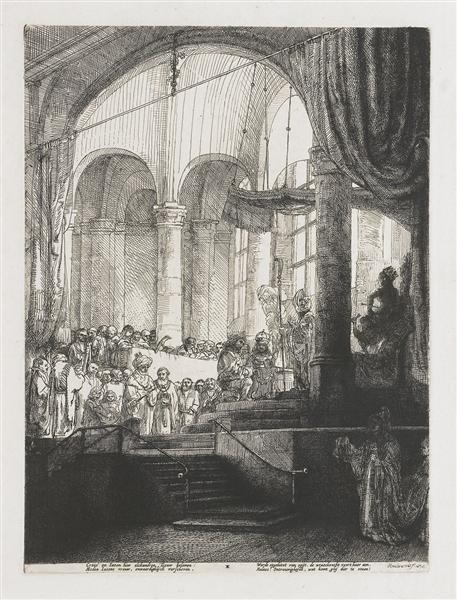Description
Rembrandt's "Medea or The Marriage of Jason and Creusa", painted in 1648, is one of those rare compositions where the Dutch master invites us to explore the complexity of human drama through the rich fusion of emotions and colors that characterize his style. This painting reflects both the dramatic narrative and the recurring themes in his work that focus on the inner struggles and morality of his characters.
At the centre of the composition is Medea, the iconic character who, as a tragic figure, embodies despair and betrayal. Her posture, with her bent body and intense gaze, radiates a mixture of anger and anguish, immediately drawing the viewer’s attention. Rembrandt, known for his skill in capturing light and shadow – his celebrated use of chiaroscuro – highlights Medea’s outline in such a way that she appears to be illuminated from within, as if her inner torment shines through the dim background. This stylistic choice not only emphasises her importance in the narrative, but also creates a sense of impending action, as if she is on the threshold of a dramatic denouement.
Surrounding Medea are other characters, most notably Jason, who is in the act of offering his hand to Creusa, his new fiancée. This interaction is loaded with symbolism, as it not only represents Jason's betrayal of Medea, but his confident, upright posture contrasts with the scorned woman's vulnerability. Rembrandt, through carefully crafted composition, balances the emotional tension that develops in the scene, using negative space to heighten the drama.
Colour in this work is equally significant. The predominant shades of deep browns and ochres suggest an atmosphere of melancholy, while the brighter hues that illuminate the characters highlight their overflowing emotions. The use of the earthy palette anticipates the sense of empathy towards Medea, who, despite her role as a villain, is presented in a state of authentic suffering. Rembrandt, often considered a master of psychological portraiture, allows these colours to dialogue directly with the emotions of his protagonists, evoking the moral ambiguity that characterises many of his works.
It is also noteworthy that this painting forms part of Rembrandt's broader interest in mythological themes and his exploration of the human condition. Throughout his career, the artist was drawn to stories that resonated through the centuries, such as the tragic narratives of classical mythology, and Medea, or The Marriage of Jason and Creusa, stands as an example of his ability to reinterpret these tales in deeply personal and psychological ways.
Although little is known about the history of this particular painting, it is clear that it encapsulates the essence of the artist and his period. The work, beyond being a representation of a classical myth, is an emotional exploration that speaks to us of love, betrayal and revenge. Rembrandt manages, through his technical mastery and his penetrating understanding of human emotions, to create a moment that transcends time and invites us to contemplate the complexity of our own interactions. In this sense, "Medea or The Marriage of Jason and Creusa" is not just a representation; it is an invitation to explore the deep and often dark nature of being human.
KUADROS ©, a famous painting on your wall.
Hand-made oil painting reproductions, with the quality of professional artists and the distinctive seal of KUADROS ©.
Painting reproduction service with satisfaction guarantee. If you are not completely satisfied with the replica of your painting, we will refund 100% of your money.

